古代爱情PK现代爱情
- 格式:ppt
- 大小:5.68 MB
- 文档页数:68
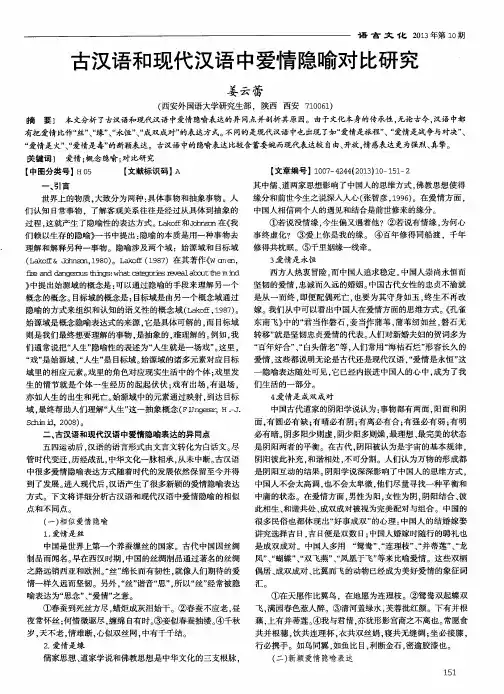

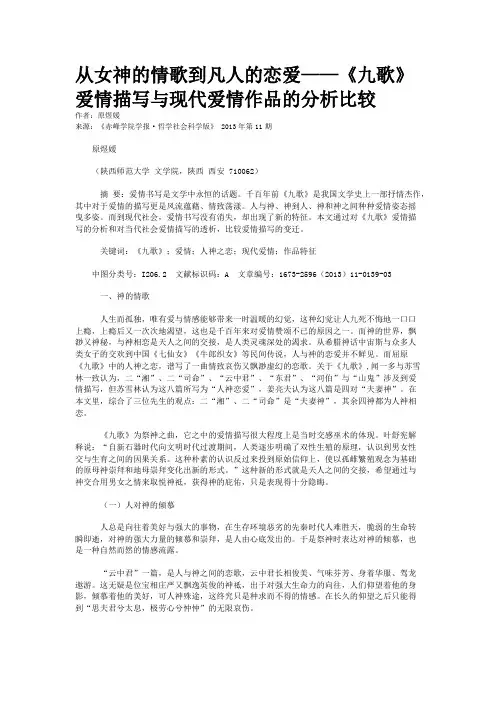
从女神的情歌到凡人的恋爱——《九歌》爱情描写与现代爱情作品的分析比较作者:原煜媛来源:《赤峰学院学报·哲学社会科学版》 2013年第11期原煜媛(陕西师范大学文学院,陕西西安 710062)摘要:爱情书写是文学中永恒的话题。
千百年前《九歌》是我国文学史上一部抒情杰作,其中对于爱情的描写更是风流蕴藉、情致荡漾。
人与神、神到人、神和神之间种种爱情姿态摇曳多姿。
而到现代社会,爱情书写没有消失,却出现了新的特征。
本文通过对《九歌》爱情描写的分析和对当代社会爱情描写的透析,比较爱情描写的变迁。
关键词:《九歌》;爱情;人神之恋;现代爱情;作品特征中图分类号:I206.2 文献标识码:A 文章编号:1673-2596(2013)11-0139-03一、神的情歌人生而孤独,唯有爱与情感能够带来一时温暖的幻觉,这种幻觉让人九死不悔地一口口上瘾,上瘾后又一次次地渴望,这也是千百年来对爱情赞颂不已的原因之一。
而神的世界,飘渺又神秘,与神相恋是天人之间的交接,是人类灵魂深处的渴求。
从希腊神话中宙斯与众多人类女子的交欢到中国《七仙女》《牛郎织女》等民间传说,人与神的恋爱并不鲜见。
而屈原《九歌》中的人神之恋,谱写了一曲情致哀伤又飘渺虚幻的恋歌。
关于《九歌》,闻一多与苏雪林一致认为,二“湘”、二“司命”、“云中君”、“东君”、“河伯”与“山鬼”涉及到爱情描写,但苏雪林认为这八篇所写为“人神恋爱”,姜亮夫认为这八篇是四对“夫妻神”。
在本文里,综合了三位先生的观点:二“湘”、二“司命”是“夫妻神”,其余四神都为人神相恋。
《九歌》为祭神之曲,它之中的爱情描写很大程度上是当时交感巫术的体现。
叶舒宪解释说:“自新石器时代向文明时代过渡期间,人类逐步明确了双性生殖的原理,认识到男女性交与生育之间的因果关系。
这种朴素的认识反过来投到原始信仰上,使以孤雌繁殖观念为基础的原母神崇拜和地母崇拜变化出新的形式。
”这种新的形式就是天人之间的交接,希望通过与神交合用男女之情来取悦神祗,获得神的庇佑,只是表现得十分隐晦。

爱情婚姻的发展历程爱情婚姻是人类社会中一种普遍存在的现象,也是人类社会进步和发展的重要因素之一。
在人类的历史长河中,爱情婚姻经历了漫长而复杂的发展过程。
本文将从古代到现代,以及未来的趋势来探讨爱情婚姻的发展历程。
古代婚姻的起源可以追溯到人类社会形成的初期。
在原始社会阶段,婚姻往往是一种生存方式和家族传承的手段。
由于物质条件的困苦和生活方式的简单,个人的感情选择往往受到其他因素的制约,如族群、家族和社会地位的考虑。
婚姻往往是由家族和社会决定的,而不是个人的自由选择。
随着人类社会的发展,封建制度的产生和发展使得婚姻的形式也发生了变化。
封建社会中的婚姻以家族和阶级的利益为主导,个人将爱情放在了次要的位置。
父母的婚姻安排成为主流,而个人的意愿往往不被重视。
这种婚姻形式在中国封建社会中尤为突出,婚姻往往是一种经济交换和家族关系的延续。
随着资本主义社会的兴起和现代国家的形成,人们对于婚姻的认识开始发生变化。
19世纪末20世纪初的西方国家,如英国、法国和美国,婚姻逐渐从父母的安排转变为个人自由选择的结果。
爱情成为决定婚姻的重要因素之一。
然而,由于社会观念和文化传统的差异,不同国家的婚姻形式呈现出多样化的发展趋势。
在现代社会,爱情婚姻的地位进一步提升,个人的自由选择成为婚姻的核心原则。
男女平等意识的增强使得传统的婚姻观念和婚姻制度受到了挑战。
婚前恋爱、同居和婚前婚姻成为普遍现象,并逐渐被社会接受。
此外,同性婚姻的合法化和多元化的婚姻模式也成为当今社会的热点议题。
尽管爱情婚姻的发展历程取得了显著的进步,但仍然存在一些问题和挑战。
婚外恋、离婚率上升、婚姻稳定性下降等现象引发了人们对于婚姻制度的思考和质疑。
此外,经济压力、职业发展以及社会变迁等因素也对爱情婚姻带来了一定的冲击。
未来,爱情婚姻的发展趋势难以预测,但可以肯定的是,个人的自主权和个性的彰显将会成为未来婚姻发展的重要方向。
科技的进步和社会的变迁将为人们创造更多的婚姻选择和可能性。
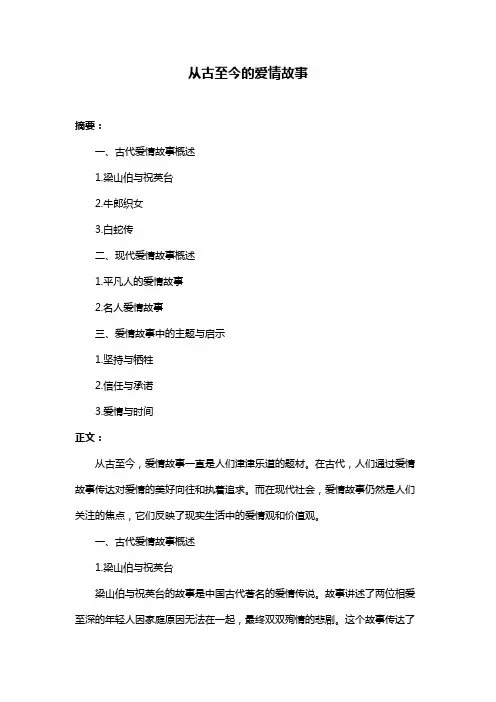
从古至今的爱情故事摘要:一、古代爱情故事概述1.梁山伯与祝英台2.牛郎织女3.白蛇传二、现代爱情故事概述1.平凡人的爱情故事2.名人爱情故事三、爱情故事中的主题与启示1.坚持与牺牲2.信任与承诺3.爱情与时间正文:从古至今,爱情故事一直是人们津津乐道的题材。
在古代,人们通过爱情故事传达对爱情的美好向往和执着追求。
而在现代社会,爱情故事仍然是人们关注的焦点,它们反映了现实生活中的爱情观和价值观。
一、古代爱情故事概述1.梁山伯与祝英台梁山伯与祝英台的故事是中国古代著名的爱情传说。
故事讲述了两位相爱至深的年轻人因家庭原因无法在一起,最终双双殉情的悲剧。
这个故事传达了古代人们对于爱情的执着和坚定信念。
2.牛郎织女牛郎织女是我国著名的民间爱情故事。
讲述了牛郎(天河星座中的牵牛星)和织女(织女星座中的织女星)之间的爱情故事。
他们因触犯天条,被银河分隔,每年只能在农历七月初七的鹊桥相会。
这个故事寓意着有情人终成眷属的美好愿望。
3.白蛇传白蛇传是一部流传已久的爱情传说。
故事讲述了白蛇和许仙之间的爱情故事。
白蛇为救夫婿许仙,不惜犯天条,盗取灵芝草。
这个故事传达了爱情中的无私奉献和勇敢精神。
二、现代爱情故事概述1.平凡人的爱情故事在现实生活中,许多平凡人的爱情故事同样感人至深。
他们或许没有梁山伯与祝英台那样的悲壮,也没有牛郎织女那样的神奇,但这些故事却充满了真挚的情感和生活的气息。
2.名人爱情故事现代社会中,名人的爱情故事也备受关注。
他们的爱情故事往往充满了戏剧性和话题性,成为人们茶余饭后的谈资。
三、爱情故事中的主题与启示1.坚持与牺牲从古至今的爱情故事中,我们看到了许多为爱情坚持和牺牲的例子。
这让我们明白,爱情需要执着和勇气,有时候为了爱情,我们需要勇敢地面对困难和挑战。
2.信任与承诺爱情中的信任和承诺是维系感情的重要纽带。
在许多爱情故事中,我们看到了信任和承诺的力量。
这让我们明白,在爱情中,信任和承诺是不可或缺的元素。
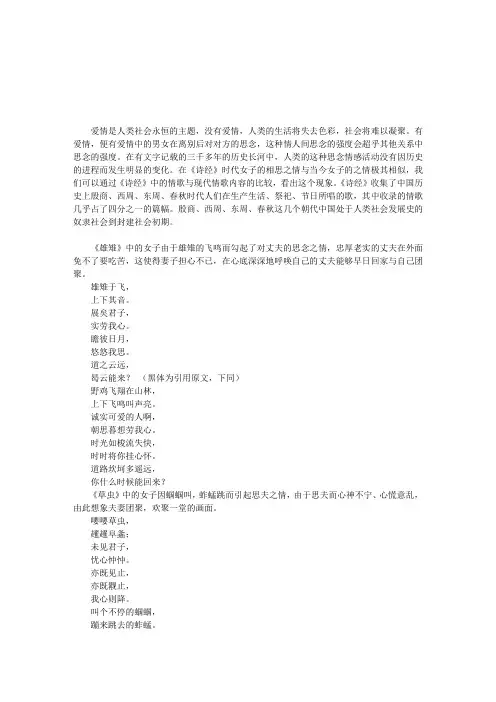
爱情是人类社会永恒的主题,没有爱情,人类的生活将失去色彩,社会将难以凝聚。
有爱情,便有爱情中的男女在离别后对对方的思念,这种情人间思念的强度会超乎其他关系中思念的强度。
在有文字记载的三千多年的历史长河中,人类的这种思念情感活动没有因历史的进程而发生明显的变化。
在《诗经》时代女子的相思之情与当今女子的之情极其相似,我们可以通过《诗经》中的情歌与现代情歌内容的比较,看出这个现象。
《诗经》收集了中国历史上殷商、西周、东周、春秋时代人们在生产生活、祭祀、节日所唱的歌,其中收录的情歌几乎占了四分之一的篇幅。
殷商、西周、东周、春秋这几个朝代中国处于人类社会发展史的奴隶社会到封建社会初期。
《雄雉》中的女子由于雄雉的飞鸣而勾起了对丈夫的思念之情,忠厚老实的丈夫在外面免不了要吃苦,这使得妻子担心不已,在心底深深地呼唤自己的丈夫能够早日回家与自己团聚。
雄雉于飞,上下其音。
展矣君子,实劳我心。
瞻彼日月,悠悠我思。
道之云远,曷云能来?(黑体为引用原文,下同)野鸡飞翔在山林,上下飞鸣叫声亮。
诚实可爱的人啊,朝思暮想劳我心。
时光如梭流失快,时时将你挂心怀。
道路坎坷多遥远,你什么时候能回来?《草虫》中的女子因蝈蝈叫,蚱蜢跳而引起思夫之情,由于思夫而心神不宁、心慌意乱,由此想象夫妻团聚,欢聚一堂的画面。
喓喓草虫,趯趯阜螽;未见君子,忧心忡忡。
亦既见止,亦既觏止,我心则降。
叫个不停的蝈蝈,蹦来跳去的蚱蜢。
见不到我的丈夫,忧愁得心神不宁,只有让我看到他,并能与他相欢聚,我的心才能放下。
《卷耳》中的女子,思念远行的丈夫,心不在焉地采卷耳菜,所以采了半天也没有采满一浅筐,最后因相思之苦无法排遣,无心再采,索性将箩筐仍在了大路上。
相思中仿佛看到了自己的丈夫旅途中登高饮酒,马困成疾,人劳生病的情景。
采采卷耳,不盈顷筐。
嗟我怀人,置彼周行。
陟彼崔嵬,我马虺隤。
我姑酌彼金罍,维以不永怀。
采了又采巻耳菜,仍装不满一浅筐。
心中思念丈夫啊,将筐丢在大路旁。
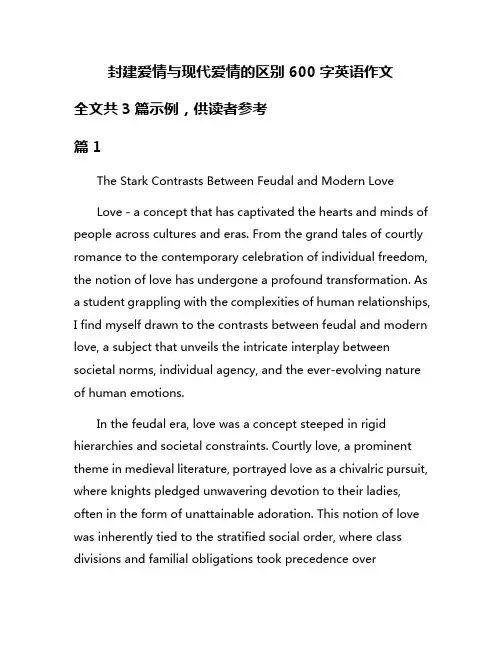
封建爱情与现代爱情的区别600字英语作文全文共3篇示例,供读者参考篇1The Stark Contrasts Between Feudal and Modern LoveLove - a concept that has captivated the hearts and minds of people across cultures and eras. From the grand tales of courtly romance to the contemporary celebration of individual freedom, the notion of love has undergone a profound transformation. As a student grappling with the complexities of human relationships, I find myself drawn to the contrasts between feudal and modern love, a subject that unveils the intricate interplay between societal norms, individual agency, and the ever-evolving nature of human emotions.In the feudal era, love was a concept steeped in rigid hierarchies and societal constraints. Courtly love, a prominent theme in medieval literature, portrayed love as a chivalric pursuit, where knights pledged unwavering devotion to their ladies, often in the form of unattainable adoration. This notion of love was inherently tied to the stratified social order, where class divisions and familial obligations took precedence overindividual desires. Arranged marriages, a common practice among the nobility, prioritized political alliances and the preservation of wealth over personal compatibility or emotional connection.The constraints of feudal love extended beyond class boundaries, as gender roles were firmly entrenched. Women were expected to embody virtues of purity, obedience, and chastity, while men were celebrated for their prowess in battle and their ability to protect and provide for their families. Love, in this context, was a carefully choreographed dance, where each participant adhered to a strict set of rules and expectations.In stark contrast, modern love is characterized by a sense of individual agency and a celebration of personal choice. The advent of industrialization and the gradual erosion of rigid social stratification have paved the way for a more egalitarian approach to relationships. Love, in contemporary times, is often rooted in mutual respect, emotional intimacy, and a shared vision for the future. Partners are encouraged to navigate their relationships based on open communication, compromise, and a deep understanding of each other's needs and desires.Furthermore, modern love embraces the notion of individual freedom and self-expression. Gone are the days when societalconventions dictated the path of romantic relationships. Today, individuals are empowered to explore their identities, challenge traditional gender roles, and forge connections that align with their personal values and aspirations. The rise of movements advocating for gender equality, LGBTQ+ rights, and overall inclusivity has reshaped the landscape of modern love, embracing diversity and celebrating the unique experiences of individuals from all walks of life.However, it would be naïve to assume that modern love is devoid of challenges and complexities. The pursuit of individual fulfillment and the prioritization of personal desires can sometimes clash with the need for compromise and mutual understanding. The breakdown of traditional family structures and the increasing mobility of modern societies have also introduced new obstacles, such as long-distance relationships and the negotiation of cultural differences.Moreover, the proliferation of digital technologies and social media has had a profound impact on the way we perceive and experience love. Online dating platforms have revolutionized the process of finding potential partners, while social media has created new avenues for communication and self-expression within relationships. Yet, this digital realm also harbors potentialpitfalls, such as the commodification of love, the blurring of boundaries between public and private spheres, and the constant pressure to curate an idealized version of one's romantic life.As a student navigating the complexities of modern love, I find myself torn between the allure of individual freedom and the yearning for a deeper, more profound connection. While the constraints of feudal love may seem antiquated and oppressive, there is a certain romanticism in the notion of unwavering devotion and the pursuit of idealized love. However, the modern approach to love, with its emphasis on mutual respect, emotional intimacy, and personal growth, resonates deeply with my values and aspirations.Ultimately, the contrast between feudal and modern love serves as a powerful reminder of the ever-evolving nature of human relationships. As societies and cultural norms shift, so too do our perceptions and experiences of love. Perhaps the true essence of love lies not in adhering to rigid conventions or societal expectations, but in the ability to navigate the complexities of human emotion with empathy,open-mindedness, and a willingness to embrace the unique journey that each individual embarks upon.In this era of rapid change and global interconnectedness, it is imperative that we approach love not as a static concept, but as a dynamic force that transcends boundaries and continually redefines itself. By embracing the lessons of history while remaining open to the possibilities of the future, we can forge a path towards a more inclusive, compassionate, and fulfilling understanding of love – one that celebrates the rich tapestry of human experience and the inherent beauty of genuine connection.篇2The Stark Contrast Between Feudal and Modern LoveLove - a universal emotion that has pervaded human existence since the dawn of civilization. Yet, the concept of love has undergone a profound transformation over the centuries, shifting from the rigid confines of feudal societies to the liberating embrace of modern times. As a student of literature and history, I have found myself captivated by the stark contrasts between these two eras, and the vastly different interpretations of love that they embodied.In the feudal ages, love was a mere afterthought, a secondary consideration to the pragmatic concerns of socialstatus, wealth, and familial alliances. Marriage was a calculated transaction, a means of consolidating power and securing strategic advantages. Love, as we understand it today, was a luxury reserved for the rare few who dared to defy the established order.The tales of star-crossed lovers from this era, such as Romeo and Juliet, resonate with us precisely because they were the exceptions that proved the rule. Their ill-fated romance was a defiant act against the oppressive societal norms that dictated the terms of acceptable love. The very notion of marrying for love was considered a foolish and dangerous notion, a threat to the delicate balance of power and inheritance.In contrast, the modern era has ushered in a radical shift in our perception of love. No longer bound by the shackles of rigid social stratification, we have the freedom to pursue love as a primary goal, a quest for emotional fulfillment and companionship. The democratization of love has allowed individuals from all walks of life to embrace the pursuit of happiness and personal fulfillment.Modern literature and cinema abound with tales of love that transcend societal barriers, celebrating the triumph of the human spirit over the artificial constructs of class, race, and tradition.From the timeless romance of "Pride and Prejudice" to the heart-wrenching drama of "Titanic," we are reminded that love knows no bounds, and that the human heart is capable of overcoming even the most daunting of obstacles.Yet, this newfound freedom has also brought with it a new set of challenges. In a world where love is a choice, rather than an obligation, the specter of commitment looms large. The abundance of options and the allure of individual freedom have, in some cases, led to a devaluation of the very concept of lasting love. The rise of divorce rates and the prevalence of fleeting relationships are testament to the double-edged sword of modern love.However, it would be a disservice to paint a wholly negative picture of modern love. For every tale of heartbreak and disillusionment, there are countless stories of enduring love, of couples who have weathered the storms of life and emerged stronger, their bond reinforced by the challenges篇3The Stark Contrast Between Feudal and Modern RomanceLove - a concept that has transcended generations and civilizations, yet its expression has undergone a remarkabletransformation over the centuries. As a student exploring the annals of history, I am struck by the profound differences between feudal and modern notions of romance. These disparities not only shed light on the evolving societal norms but also underscore the profound impact of cultural and ideological shifts on one of humanity's most cherished experiences.In the feudal era, love was a complex tapestry woven with threads of duty, obligation, and strategic alliances. Marriages were seldom a matter of personal choice or affection but rather a calculated move on the chessboard of power and influence. Aristocratic unions were forged to strengthen political ties, consolidate wealth, and secure dynastic continuity. Love, in its purest sense, was often a secondary consideration, relegated to the realm of courtly love – a chivalric tradition that idealized the concept of unrequited love between a knight and a noble lady.This notion of courtly love gave rise to a peculiar paradox: while marriages were arranged for pragmatic reasons, the art of romantic poetry and chivalric gestures flourished. Knights would embark on grand quests and daring exploits to win the favor of their beloved, adorning her with lavish gifts and composing elaborate verses that celebrated her beauty and virtue. However, these displays of affection were rarely consummated, as thesocietal conventions of the time deemed physical intimacy outside of marriage a grievous sin.In stark contrast, modern romance has shed the shackles of obligation and embraced the pursuit of personal fulfillment. Love, in our contemporary era, is a matter of choice – a meeting of hearts and minds unburdened by the weight of political calculations or familial expectations. Individuals are free to explore their emotions, navigate the complexities of attraction, and forge connections based on mutual understanding and compatibility.The advent of dating culture has revolutionized the way we approach romance. Gone are the days of arranged unions; instead, we revel in the thrill of courtship, the exchange of flirtatious glances, and the delicate dance of getting to know one another. Modern love is a journey of self-discovery, where individuals seek partners who complement their values, aspirations, and lifestyles.Furthermore, the notion of physical intimacy has undergone a seismic shift. While once considered taboo outside the sanctity of marriage, modern society has embraced a more open and inclusive perspective. Physical expression is viewed as a natural extension of emotional intimacy, a celebration of mutual desireand connection – a stark departure from the chaste ideals of courtly love.Yet, amidst these transformations, certain enduring aspects of love remain unchanged. The yearning for companionship, the desire to be cherished and understood, and the profound connection that transcends mere physical attraction – these are timeless elements that have resonated throughout human history. Whether in the grandiose halls of feudal castles or the cozy confines of modern apartments, love continues to be a universal language that knows no bounds.As I reflect on these contrasting paradigms, I am struck by the resilience of the human spirit and its capacity to adapt and evolve. Love, once constrained by societal conventions and political machinations, has blossomed into a vibrant expression of individual choice and personal fulfillment. While the trappings of romance may have changed, the essence of love – that profound, ineffable bond that binds souls together – remains an enduring constant, a beacon that guides us through theever-changing tides of human experience.。
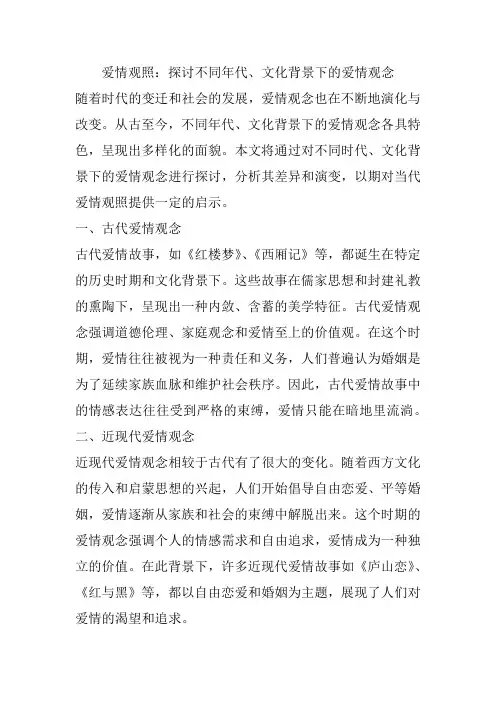
爱情观照:探讨不同年代、文化背景下的爱情观念随着时代的变迁和社会的发展,爱情观念也在不断地演化与改变。
从古至今,不同年代、文化背景下的爱情观念各具特色,呈现出多样化的面貌。
本文将通过对不同时代、文化背景下的爱情观念进行探讨,分析其差异和演变,以期对当代爱情观照提供一定的启示。
一、古代爱情观念古代爱情故事,如《红楼梦》、《西厢记》等,都诞生在特定的历史时期和文化背景下。
这些故事在儒家思想和封建礼教的熏陶下,呈现出一种内敛、含蓄的美学特征。
古代爱情观念强调道德伦理、家庭观念和爱情至上的价值观。
在这个时期,爱情往往被视为一种责任和义务,人们普遍认为婚姻是为了延续家族血脉和维护社会秩序。
因此,古代爱情故事中的情感表达往往受到严格的束缚,爱情只能在暗地里流淌。
二、近现代爱情观念近现代爱情观念相较于古代有了很大的变化。
随着西方文化的传入和启蒙思想的兴起,人们开始倡导自由恋爱、平等婚姻,爱情逐渐从家族和社会的束缚中解脱出来。
这个时期的爱情观念强调个人的情感需求和自由追求,爱情成为一种独立的价值。
在此背景下,许多近现代爱情故事如《庐山恋》、《红与黑》等,都以自由恋爱和婚姻为主题,展现了人们对爱情的渴望和追求。
三、当代爱情观念当代爱情观念受到全球化、网络化等因素的影响,呈现出更为多元和复杂的态势。
现代社会中,爱情观念逐渐与物质生活、精神追求相结合,人们在追求爱情的过程中,既要面对现实的压力,也要面对内心的挣扎。
当代爱情故事如《北京遇上西雅图》、《致青春》等,反映了当代社会中人们对爱情的期许、困惑和反思。
四、不同文化背景下的爱情观念不同文化背景下的爱情观念具有鲜明的民族特色。
如西方文化中的爱情,强调个人的自由和独立,爱情观较为开放;而东方文化中的爱情,注重家庭观念和道德伦理,爱情观相对较为保守。
随着全球化的推进,东西方爱情观念逐渐交融,形成了一种全新的爱情观。
总结不同时代、文化背景下的爱情观念具有各自的特色,但归根结底,爱情都是人类最美好的情感之一。
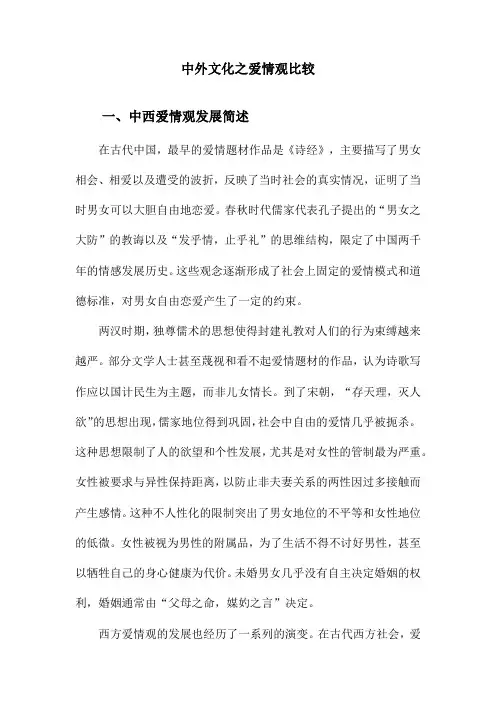
中外文化之爱情观比较一、中西爱情观发展简述在古代中国,最早的爱情题材作品是《诗经》,主要描写了男女相会、相爱以及遭受的波折,反映了当时社会的真实情况,证明了当时男女可以大胆自由地恋爱。
春秋时代儒家代表孔子提出的“男女之大防”的教诲以及“发乎情,止乎礼”的思维结构,限定了中国两千年的情感发展历史。
这些观念逐渐形成了社会上固定的爱情模式和道德标准,对男女自由恋爱产生了一定的约束。
两汉时期,独尊儒术的思想使得封建礼教对人们的行为束缚越来越严。
部分文学人士甚至蔑视和看不起爱情题材的作品,认为诗歌写作应以国计民生为主题,而非儿女情长。
到了宋朝,“存天理,灭人欲”的思想出现,儒家地位得到巩固,社会中自由的爱情几乎被扼杀。
这种思想限制了人的欲望和个性发展,尤其是对女性的管制最为严重。
女性被要求与异性保持距离,以防止非夫妻关系的两性因过多接触而产生感情。
这种不人性化的限制突出了男女地位的不平等和女性地位的低微。
女性被视为男性的附属品,为了生活不得不讨好男性,甚至以牺牲自己的身心健康为代价。
未婚男女几乎没有自主决定婚姻的权利,婚姻通常由“父母之命,媒妁之言”决定。
西方爱情观的发展也经历了一系列的演变。
在古代西方社会,爱情被视为一种神圣的情感,与婚姻和家庭紧密相连。
随着社会的发展和思想的变迁,西方爱情观逐渐发生了变化。
在中世纪的欧洲,由于基督教的影响,爱情被赋予了更多的精神和宗教意义。
人们开始追求纯洁、无私的爱情,强调情感的升华和灵魂的契合。
这一时期的爱情观仍然受到社会等级和婚姻制度的限制。
随着文艺复兴和启蒙运动的兴起,西方社会开始强调个人的自由和权利,爱情观也发生了相应的变化。
人们开始追求基于个人情感和选择的爱情,强调平等、尊重和自由。
爱情不再仅仅是婚姻的前提,而成为一种独立的、有价值的人生体验。
进入现代社会后,西方爱情观继续演变。
人们更加注重个人的感受和需求,追求更加开放、多元和包容的爱情关系。
同时,随着社会的进步和技术的发展,人们对于爱情的理解和实践也在不断发生变化。
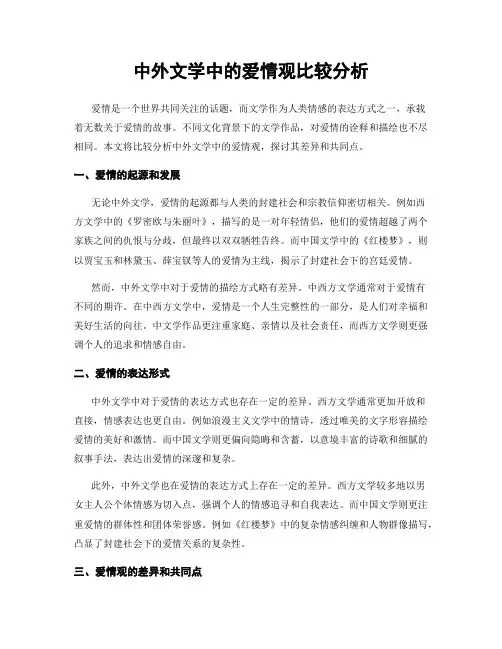
中外文学中的爱情观比较分析爱情是一个世界共同关注的话题,而文学作为人类情感的表达方式之一,承载着无数关于爱情的故事。
不同文化背景下的文学作品,对爱情的诠释和描绘也不尽相同。
本文将比较分析中外文学中的爱情观,探讨其差异和共同点。
一、爱情的起源和发展无论中外文学,爱情的起源都与人类的封建社会和宗教信仰密切相关。
例如西方文学中的《罗密欧与朱丽叶》,描写的是一对年轻情侣,他们的爱情超越了两个家族之间的仇恨与分歧,但最终以双双牺牲告终。
而中国文学中的《红楼梦》,则以贾宝玉和林黛玉、薛宝钗等人的爱情为主线,揭示了封建社会下的宫廷爱情。
然而,中外文学中对于爱情的描绘方式略有差异。
中西方文学通常对于爱情有不同的期许。
在中西方文学中,爱情是一个人生完整性的一部分,是人们对幸福和美好生活的向往。
中文学作品更注重家庭、亲情以及社会责任,而西方文学则更强调个人的追求和情感自由。
二、爱情的表达形式中外文学中对于爱情的表达方式也存在一定的差异。
西方文学通常更加开放和直接,情感表达也更自由。
例如浪漫主义文学中的情诗,透过唯美的文字形容描绘爱情的美好和激情。
而中国文学则更偏向隐晦和含蓄,以意境丰富的诗歌和细腻的叙事手法,表达出爱情的深邃和复杂。
此外,中外文学也在爱情的表达方式上存在一定的差异。
西方文学较多地以男女主人公个体情感为切入点,强调个人的情感追寻和自我表达。
而中国文学则更注重爱情的群体性和团体荣誉感。
例如《红楼梦》中的复杂情感纠缠和人物群像描写,凸显了封建社会下的爱情关系的复杂性。
三、爱情观的差异和共同点中外文学中的爱情观既存在差异,也存在共同点。
差异体现在对于爱情的定义、期许和表达方式上。
不同文化背景和历史背景对于爱情的诠释和体验也会有所不同。
然而,中外文学中对于爱情的追求和反思存在共同点。
爱情是一种普遍存在的情感体验,无论是中文学还是西方文学,都有追求真爱、执着忠诚等共通的主题。
从现代角度看,中外文学中的爱情观也在相互融合和影响。
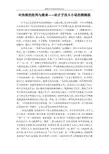
对传统的批判与继承——论才子佳人小说的婚姻观才子佳人小说是明末清初涌现的一大批小说,是人情小说的一个分支和流派。
在这类小说中"男女以诗为媒介,由爱才而产生了思慕与追求,私订终身结良缘,中经豪门权贵为恶构隙而离散多经波折终因男中三元而团圆。
"(《烟粉新诂》)可见从题材上说,是写才子佳人的恋爱故事,其情节构成,大多是郊游偶遇,题诗传情,梅香撮合,私订终身。
其结局或因命运乖违,或因小人拨弄,或出政事牵连,于是佳人逼嫁,才子遭难,但虽经波折,却坚贞如一。
后来或由于才子金榜题名,或由于圣君贤吏主持正义,终于"有情人终成眷属"。
从形式上说,一是相当部分作品书名模仿《金瓶梅》,用主人公的名字命名作品。
如《玉娇梨》、《平山冷燕》、《金云翘传》、《春柳莺》、《雪月梅》等。
二是一般在十六回至二十回之间,均十万字左右,相当于现代一部中篇小说的篇幅。
鲁迅在《中国小说的历史变迁》中说:“才子和佳人之遇合,就每每以题诗为媒介。
”山、冷、平、燕四人在婚恋的过程中,两对青年男女以诗为“媒”,双方都大胆的追求心之所属。
山黛和冷绛雪、平如衡和燕白颔结识之初便是以作诗互相钦佩,山燕二人在皇庄因诗互相倾慕、冷平二人在寺庙因诗互相欣赏。
平如衡和冷绛雪的第一次相遇是冷绛雪在去山府途中路过闵子庙时题诗一首,平如衡见后,立马依韵和诗一首,两人因此相识。
平如衡和诗:“又见千秋绝妙词,怜才真性孰无之?倘容秣马明吾好,愿得人间衣尽缁。
”这首诗词意深婉,对冷绛雪的诗大力的夸赞。
冷绛雪在看完这首诗后也称赞其才华,更是直言自己遇见了知己,离开后还念念不忘。
燕白颔在去城南闲耍的路上,偶然闯进了皇庄,遇见了正在皇庄看望父亲的山黛。
遇见了知己,从此对佳人倾心。
古代男子在遇见了心仪的女子时有很多种表达方式,比如直接表达,绘画等其他方式,但这里的才子唯独选择通过诗歌来表达自己的心意。
可见,在才子眼中,利用诗歌来表达自己的心意,一方面能够衬出佳人的美貌,另一方面能够表现出个人的才华。
中图分类号:D90 密级:公开UDC:340 学校代码:11832河北经贸大学硕士学位论文中国古今婚姻制度比较China's ancient and modern marriage system作者姓名:张婷指导教师:张振国教授学科专业名称:法学硕士论文完成日期:2013年3月二〇一三年三月八日中图分类号:D90 密级:公开UDC:340 学校代码:11832河北经贸大学硕士学位论文中国古今婚姻制度比较China's ancient and modern marriage system作者姓名:张婷指导教师:张振国教授学科专业名称:法学硕士论文完成日期:2013年3月I学位论文原创性声明本人所提交的学位论文《中国古今婚姻制度比较》是在导师的指导下,独立进行研究工作所取得的原创性成果。
除文中已经注明引用的内容外,本论文不包含任何其他个人或集体已经发表或者撰写过的研究成果。
对本文的研究做出重要贡献的个人和集体,均已在文中标明。
本声明的法律后果由本人承担。
论文作者:指导老师确认:年月日年月日学位论文版权使用授权书本学位论文作者完全了解河北经贸大学有权保留并向国家有关部门或机构送交学位论文的复印件和磁盘,允许论文被查阅和借阅。
本人授权河北经贸大学可以将学位论文的全部或部分内容编入有关数据库进行检索,可以采用影印、缩印或其它复制手段保存、汇编学位论文。
(保密的学位论文在年后适用本授权书)论文作者:指导老师:年月日年月日II摘要婚姻制度是社会制度的重要组成部分,婚姻把单个的人组建成家庭,家庭是连接个人与社会的重要中间环节,是社会组成的基石。
婚姻制度是建立在一定经济基础之上的上层建筑,因此具有社会制度或上层建筑的共同特性,在特定的社会形态下婚姻制度的内容、形式、性质都有不一样的社会背景,特定的婚姻制度能反映出这个社会的文化传统、社会发展水平、物质生活条件。
生产方式、社会制度的变革也是婚姻家庭制度发展变化的根本诱因。
古代爱情观
古代爱情观是指在古代社会中,人们对待爱情的观念和态度。
古代社会通常是以婚姻为基础的社会结构,爱情被看作是婚姻的一种必要条件。
然而,古代的爱情观与现代有着明显的差异。
在古代,爱情常常被视为一种理性的选择,而非个人情感的体现。
人们更注重家族背景、财富和地位等因素,而不是纯粹的个人感情。
父母通常会为子女安排婚姻,以确保家族利益的延续和继承。
因此,个人的感情和意愿在婚姻选择中并不是最重要的因素。
古代的爱情观还强调责任和忍耐。
婚姻被视为一种契约,夫妻应该相互扶持、包容和忍耐。
离婚在古代是罕见的,并且被视为一种破坏家庭和社会稳定的行为。
夫妻之间的感情问题通常会通过家族和社会的干预来解决,而不是通过离婚。
古代的爱情观也受到了伦理和道德观念的制约。
性爱被视为婚姻中的一部分,而不是仅仅个人的欲望满足。
婚姻被认为是为了繁衍后代和家族延续,而不是仅仅为了个人的快乐和满足。
因此,夫妻之间的感情和性爱需遵循一定的道德规范和社会期望。
然而,尽管古代爱情观与现代有很大不同,但也存在一些例外情况。
在一些文学作品中,如《红楼梦》和《牡丹亭》,描绘了一些超越传
统爱情观的故事。
这些作品中的人物展现了对爱情的追求和执着,超越了社会的束缚和道德的限制。
总结来说,古代爱情观强调婚姻的理性选择、责任和忍耐,以及伦理和道德的限制。
尽管个人的感情和意愿在婚姻选择中不是最重要的因素,但一些文学作品中展现了一些超越传统观念的爱情故事。
以秦观为例,浅谈古代爱情词与现代爱情诗歌之间的异同第一篇:以秦观为例,浅谈古代爱情词与现代爱情诗歌之间的异同以秦观为例,浅谈古今爱情词的异同【摘要】秦观是北宋婉约词派的代表人物,他的爱情词尤为后世所称颂。
随着时间的推移,人们对爱情的态度和感触也发生着变化,这些变化,在诗词的意象中表现的淋漓尽致。
本文将以秦观的爱情词为例,阐述古代爱情词与现代诗歌中的意象及其抒发的情感的异同。
【关键词】秦观爱情诗歌意象古往今来,爱情都是文人骚客所向往的话题。
从“青青子衿,悠悠我心。
”,到“北方有佳人,遗世而独立。
一笑倾人城,再笑倾人国。
”,到“两情若是久长时,又岂在朝朝暮暮。
”,再到“我如果爱你,绝不像攀援的凌霄花。
”……诗人们对于爱情的热爱从来都没有减少,改变的,只是他们对于爱情的态度和理念;而这些变化,我们往往可以从古今爱情词中的意象中窥探一二。
意象是中国古代诗学中的一个重要的范畴,是诗歌不同于其他文学样式的独特的呈现方式,诗人的创作灵感与对生活、生命的体验都凝聚于其中,意象也同样是诗人和读者之间的桥梁。
通过这座桥,诗人和读者才能够进行心灵上的沟通。
由此可见,意象的内涵是十分丰富的,而在中外的诗学中,意象的概念众说纷纭,但是我们普遍比较认可的一个说法,是把意象作为一种心物交感互渗的审美产物。
因此,意象最重要的两个因素,就是“心”和“物”。
所谓“心”,就是作者的内心感受,所谓“物”,就是客观的事物,当诗人看到某个客观事物而引发了自己内心的感受,使得诗人将这个事物和自己所感所想联系在一起的时候,意象就产生了。
比如,我们说到明月,就能联想到思乡情结;我们说道青鸾就能联想到相思;说到荷花就联想到高洁……这些都是大家耳熟能详的传统意象。
而宋词之中的与爱情有关联的意象也是数不胜数,比如红烛(洒空阶,夜阑未休,故人剪烛西窗语。
周邦彦《琐窗寒》),比如红豆(玲珑骰子安红豆,入骨相思知不知。
温庭筠《杨柳枝》),比如捣衣(飞鸿影里,捣衣砧外,总是玉关情。
古代人和现代人谈恋爱的区别
古代人和现代人谈恋爱有啥区别?
十一个区别:
1、古代女孩不敢见男朋友是因为父母没点头,现代女孩不敢见男朋友是因为没洗头。
2、古代人到了结婚才见面,现代人见面一万次也不想结婚。
3、古代女孩给男孩缝香包,现代是男孩给女孩买包包。
4、古代人剪下头发交给对方表示结发为夫妻,现代人剪下头发代表分手了,从头再来。
5、古代搭讪是这个妹妹我曾见过的,现代搭讪是加个微信吧,小姐姐。
6、古代秀才高考途中谈个恋爱成为佳话,现代高考之前谈恋爱被老师找去谈话。
7、古代的爱情故事被写成名曲《梁祝》,现代的爱情故事被写成歌曲《两只蝴蝶》。
8、古代的爱情故事开始的时候是在大雨中借伞,现代的爱情故事是结束之后在大雨中大喊。
9、古代小仙女谈恋爱会被娘家带上天,现代小仙女谈恋爱会被男朋友宠上天。
10、古代秀恩爱叫凤求凰,现代秀恩爱叫撒狗粮。
11、古代谈恋爱是父母包办,现代谈恋爱是父母在公园发传单。
古希腊神话中的爱情故事与现代爱情观念的异同1. 引言1.1 概述古希腊神话作为世界文化遗产之一,其中的爱情故事一直以来都吸引着人们的关注。
这些神话中的爱情故事展示了古希腊人对爱情的理解与追求,同时也对现代社会中的爱情观念产生了深远影响。
本文将通过探讨古希腊神话中几个重要的爱情故事,并与现代爱情观念进行对比,旨在揭示古希腊神话对于现代爱情观念发展的启示。
1.2 文章结构本文主要分为以下几个部分:引言、古希腊神话中的爱情故事、现代爱情观念的异同、分享古希腊爱情故事对现代爱情观念的启示以及结论。
首先我们将介绍本文研究的背景和目的,然后详细讨论古希腊神话中三个具有代表性的爱情故事。
接着我们将对比这些神话中展现出来的爱情观念和现代社会中普遍存在的爱情观念的异同之处。
在最后一部分,我们将分享古希腊爱情故事对现代爱情观念的启示,并总结出本文的主要发现和贡献。
1.3 目的本文旨在通过对古希腊神话中爱情故事与现代爱情观念进行比较与探讨,揭示两者之间的异同,并思考古希腊神话对于现代爱情观念的启示。
通过深入研究这些故事,我们可以更好地理解古希腊人对于爱情的追求和态度,并借鉴其智慧来指导和丰富当前社会中的爱情观念。
有了这样的认识,我们可以更好地理解和处理自己的感情关系,建立健康、平等、尊重他人选择以及接纳多样性和差异性的现代爱情观念。
2. 古希腊神话中的爱情故事2.1 爱神阿佛洛狄忒与心上人在古希腊神话中,阿佛洛狄忒是美丽与爱的女神。
她常常被描述为无所畏惧、充满热情的形象。
根据神话故事,阿佛洛狄忒曾深深地爱上了心上人。
然而,她的爱情经历并不总是顺利的。
有时,她的感情会带来伤害和痛苦。
2.2 玛俄与赫淮斯托斯之婚其中一个古希腊神话中著名的爱情故事是关于玛俄和赫淮斯托斯之间的婚姻。
玛俄被描绘为美丽而富有智慧的女神,而赫淮斯托斯则是一个残障聪明但相貌丑陋的男神。
他们两个看起来形成了一个不平衡的组合,但这个故事告诉了我们物质和外表并不应该是决定爱情是否存在或持久的关键因素。